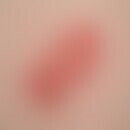DefinitionThis section has been translated automatically.
Hyper- and hypothyroidism belong to the most important thyroid diseases from a dermatological point of view.
- Besides diabetes mellitus, hyperthyroidism is the most common endocrine disease in adults with a gynaecotropy of 5:1 and is rare in children. Hyperthyroidism includes all diseases that are associated with a peripheral oversupply of thyroid hormones. The two most common are autoimmune hyperthyroidism(immunogenic hyperthyroidism of the M. Graves type) and functional autonomy (autonomous adenoma or multinodular goiter).
- Hypothyroidism can be congenital (1:5,000 newborns) or acquired. Acquired most frequently as a consequence of chronic lymphocytic thyroiditis(autoimmune thyroiditis Hashimoto), rarely also in the context of a polyglandular autoimmune syndrome or iatrogenic (e.g. after strumectomy).
ClassificationThis section has been translated automatically.
Overview of the most common dermatologic symptoms and disorders in thyroid disease:
- Skin changes in hyperthyroidism:
- Acropachy (irregular periosteal proliferation on the end phalanges of the fingers and toes I to III).
- Alopecia areata
- Alopecia, diffuse
- Alopecia: along the frontal hairline with displacement of the frontal hairline cranially. Patchy, hairless patches.
- EMO syndrome (exophthalmos pretibial myxedema osteoarthropathy syndrome).
- Hyperhidrosis
- Hyperpigmentation (localized periorbital or generalized - see below melasma)
- Koilonychia
- Mucinosis cutaneous infantile (questionable association)
- Myxedema, pretibial
- myxoedema, diffuse
- Onycholysis.
- Skin changes in hypothyroidism:
- Acropachy (hypertrophy of long bones, distal bone ends and skin of extremities with drumstick fingers).
- Eruptive xanthomas
- Hair: rough and shaggy, breaks off easily
- Slow hair growth
- Skin, dry, cold, rough
- Capillary fragility
- Macroglossia
- Myxedema
- Nails thin, streaky
- Nail growth, delayed
- Onycholysis (rare)
- Pachydermoperiostosis, symptomatic
- Rarefication of the lateral eyebrows
- Drumstick finger.
- Skin changes in autoimmune thyroiditis (Hashimoto's):
- Canities praecox (pernicious anemia; thyroiditis).
- Dermatitis herpetiformis (Hashimoto's thyroiditis)
- Cat scratch disease (complicative thyroiditis)
- Lichen sclerosus et atrophicus
- Myxoedema circumscriptum symmetricum praetibiale (Hashimoto's thyroiditis is rare)
- Polychondritis recidivans et atrophicans (Hashimoto's thyroiditis)
- Pruritus sine materia
- Sjögren's syndrome (Hashimoto's thyroiditis; anti-SS-A and/or anti-SSB AK)
- Scleroderma, systemic
- Urticaria (immunological)
- Vitiligo (Hashimoto's thyroiditis)
- S.a. Polyendocrinologic syndrome, autoimmunologic.
- Skin lesions and thyroid tumors:
- Acanthosis nigricans maligna in thyroid carcinoma.
- Amyloidosis (medullary thyroid carcinoma)
- Birt-Hogg-Dubé syndrome (thyroid carcinoma, hypothyroidism)
- Cowden syndrome (thyroid carcinoma)
- MMN syndrome
- Sipple syndrome (multiple endocrine neoplasia, including thyroid carcinoma)
- Wermer syndrome.
You might also be interested in
ClinicThis section has been translated automatically.
- Dermatological leading symptoms of hyperthyroidism are:
- Hyperhidrosis with tender, velvety skin
- heat intolerance
- brittle nails
- fine thin hair.
- In the full-blown Graves ' disease, diffuse, periorbital hyperpigmentation (haloed eyes) is pronounced in addition to exophthalmos. If the hyperpigmentation intensifies in the inner corner of the eye, it is called a "Jellinek's sign".
- In hypothyrosis, congenital and acquired hypothyroidism are distinguished. For dermatologic differential diagnosis, the symptoms of the acquired forms are particularly significant. Acquired forms of hypothyroidism are observed from the age of 2 years. The following dermatological symptoms are relevant:
- increased sensitivity to cold
- dry, somewhat thickened, rough (knees and elbows increased) pale skin (with yellowish undertone)
- Myxedema with doughy, non-push-in swellings of the eyelids, face, hands and lower legs.
LiteratureThis section has been translated automatically.
- Ai J, Leonhardt JM et al (2003) Autoimmune thyroid diseases: etiology, pathogenesis, and dermatologic manifestations. J Am Acad Dermatol 48: 641-659
- Heymann WR (1992) Cutaneous manifestations of thyroid disease. J Am Acad Dermatol 26: 885-902
- Jabbour SA (2003) Cutaneous manifestations of endocrine disorders: a guide for dermatologists. At J Clin Dermatol 4: 315-331
Incoming links (8)
Autoimmune diseases; Dermadrome; Dermatitis-arthritis syndromes; Dermatitis herpetiformis; Hypothyroidism and skin changes; Immunogenic hyperthyroidism; Melasma; Neuropathic ulcer ;Outgoing links (37)
Acanthosis nigricans maligna; Acropacity; Alopecia areata (overview); Alopecia exogenica diffusa; Alopecia (overview); Amyloidosis (overview); Birt-hogg-dubé syndrome; Cat scratch disease; Chronic lymphocytic thyroiditis; Cowden syndrome; ... Show allDisclaimer
Please ask your physician for a reliable diagnosis. This website is only meant as a reference.




